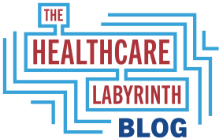One of my Christmas traditions is to write about the release of the Centers for Medicare and Medicaid Services (CMS) Actuary’s National Healthcare Expenditure Data (NHED) for a given calendar year. This usually is released in the first half of December each year for the prior year. It literally takes CMS about a year to capture, calculate and categorize all the data for a year given the size and labyrinthine complexity of our healthcare system. Each year as well, usually in the first half of June, the CMS Actuary updates healthcare spending projections for ten outyears.
Why is this so important? First, it is the main comprehensive source of data for calculating the history and future of healthcare spending. Most other studies rely on the CMS Actuary’s NHED reports in some way. Second, it is a treasure trove of data that helps explain the inner workings of the healthcare system. Here you will find data by line of business, by service type, source of payment, and more. Last, since it calculates the amount of gross domestic product (GDP) devoted to healthcare spending each year, it is the official statistic for how we are performing on the cost side against other developed nations.
Before we get into the specifics, while 2022 saw the percentage of GDP devoted to healthcare decline, this is tied to the anomalies of federal COVID appropriations and spending over the past few years. The fact remains that America is a huge outlier in terms of healthcare spending in the developed world despite some positive trends I outline below. I usually say that the United States spends anywhere from 50% more (against the highest spending grouping of other developed nations) to 100% more (against the developed world average). This continues to hold true despite the decline reported by the CMS Actuary.
And as I often say, too, the value in the U.S. system is abominable. We spend the most by far of any developed nation, yet we rank dead last in terms of outcomes on a recent Commonwealth Fund study. It is not just that we are dead last, but that we are a quality outlier even against the lowest performing developed nations in the study. If you haven’t read it yet, see my November 30 Blog at the blog tab of this site for complete details. In addition, my book, The Healthcare Labyrinth (available for purchase via this site), goes into details about why we are so dysfunctional (using the NHED reports) and how we can close the gaps on costs and outcomes.
Let’s get to the findings from the CMS Actuary for 2022
Let’s dig into the numbers from the 2022 NHED. But here is an admonition: as I alluded to above, NHED statistics have been skewed for 2020, 2021, and 2022 due to the COVID pandemic and congressional funding. Because of definitions of healthcare expenditures used by the CMS Actuary, much of the supplemental COVID appropriations related to healthcare are captured in the 2020, 2021, and 2022 NHED calculations. This had its biggest effect in 2020, to a lesser degree in 2021, and to an even lesser degree in 2022. But there remains a sizeable increase in federal spending in the calculation even in 2022. In general, we saw a surge in the percentage of GDP devoted to healthcare in 2020 (two percentage points) followed by a drop in 2021 and again in 2022. We are returning to our historic but still high GDP figure in 2022.
Some NHED findings for 2022:
- Total national health expenditures grew by $176 billion in 2022 compared with 2021.
- U.S. health care spending grew 4.1% to reach $4.465 trillion in 2022. This is faster than the increase of 3.2% in 2021, but much slower than the rate of 10.6% in 2020.
- The 4.1% figure represents a relatively moderate growth number. As an example, the average from 2016 to 2019 was 4.4%.
- The share of GDP devoted to health care fell to 17.3% in 2022, lower than both the 18.2% share in 2021 and the highest level of 19.5% in 2020. During 2016-19 the average share was 17.5%, showing a return to historic levels.
- We did see major growth in Medicaid and private health insurance spending, but it was offset by the decline in COVID spending.
- We also saw a historic high of 92% insured. Still, 8% remains a huge crisis for America when the rest of the developed world averages a 1% uninsured rate.
- In some ways the decline (with and without COVID spending) is interesting as we are seeing hyper-inflation in the United States. It is not hitting healthcare to a great degree, except in a few instances.
- Adjusting for COVID funding, we do see a pronounced slowing of hospital services growth (it still increased), while prescription drug costs continue their march upward.
- Out-of-pocket healthcare expenditures increased in 2022, averaging $1,425 per capita (this does not include the amount individuals contribute toward premiums). That shows the cost crunch the American public see everyday despite moderate statistics otherwise.
- Government health insurance expenditures have surged over the past few decades and have become the largest source of healthcare funding. This surge remains true over the past decade, tied to aging in America and system inefficiencies impacting Medicare and the Affordable Care Act (ACA) eligibility expansion in Medicaid.
What does it all mean?
Moderation in the growth of spending and a stabilization of healthcare spending as a percentage of GDP was only seen one time before when managed care began taking hold in the system at the end of the last century and into this one. I explain in my book that when managed care was accepted broadly in the United States, we saw a rough flattening of healthcare spending as a percentage of GDP. Just after this, we saw the so-called managed care backlash, which led insurers to loosen major managed care restrictions and create less prescriptive products. That led to a surge in costs and a return to growth in healthcare spending as a percentage of GDP.
Interestingly, too, some recent studies have discussed the huge mismatch between earlier predictions of healthcare spending growth and what has emerged in the past decade or so. We are seeing some of this in the moderate growth statistics. The difference appears largely to be in the area of per-person costs rather than in the number of people enrolled and other aggregate factors. There are a few reasons for this: First, quite simply, economists hedged their predictions given past growth. We also had over-estimates of spending in government programs. Second, it would appear that advances in healthcare (whether drugs, procedures, or screenings) have helped reduce the incidence and costs of certain diseases (not that our track record is good here). Third, others also point to the increase in coverage as a reason for the leveling off. It actually helped save in terms of more expensive care. Last, the advent of value-based care (where compensation of providers is now focused more on cost control and outcomes) may have played some role, too.
As I say, the CMS Actuary will update predictions for the long term in June 2024. In June 2023, the CMS Actuary predicted healthcare spending would be $4.439.8 trillion. It came in at $4.465 trillion – only a $25 billion miss with all the COVID fallout occurring. Not bad. At the time, the actuary said healthcare spending would grow to $7.175 trillion by 2031. Healthcare spending would represent 19.6% of GDP – roughly that one-fifth magic number we often worry about.
Based on some of the latest trends, we will know whether the CMS Actuary will change the predictions lower or not in June. But the fact remains that we are in store for some sort of increase of up to $2.71 trillion, or up to 60%. Even if the number comes down because we are benefiting from what some analysts say is a technology-driven, well-being dividend, the trends still show a system that is unaccountable and unsustainable. We have an aging phenomenon, a high uninsured and underinsured rate, a fractured and inefficient system, a price problem, little focus on care management, wellness, and prevention, and more. So, don’t get too excited by the NHED report for 2022. We still have a system in crisis that badly needs reform.
#healthcare #healthinsurance #healthcarereform #costs #nhed #cms #cmsactuary #healthcarespending
— Marc S. Ryan





